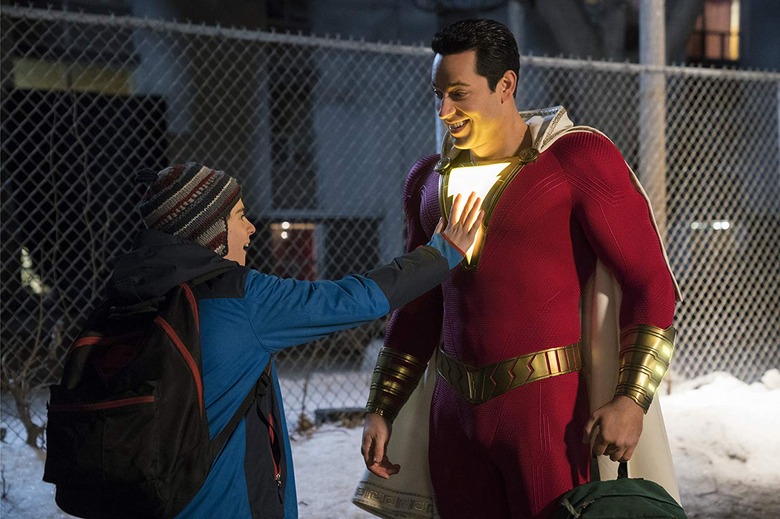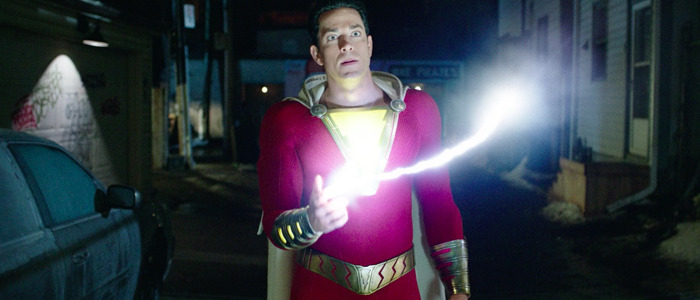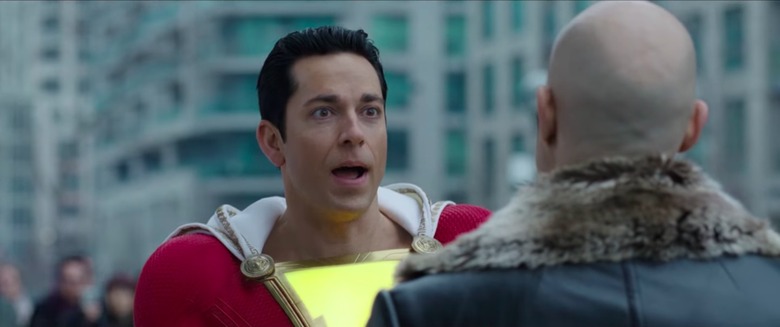'Shazam!' Realizes That Being A Superhero Should Be Actually Fun – And It's One Of The Best DC Movies Yet
Throughout the last few years, among superhero films, there's been an easy way to boil it down: Marvel movies are (by and large) fun, and DC movies are super-dark and grim. In the latter case, a couple of auteurs (whether you like them or not) created the template for the entire DC Extended Universe, even though one of them never directed a film within that technically defined franchise: Christopher Nolan and Zack Snyder. The darkness of these films has arguably become a burden, and one that DC is now self-aware about. Their last two films, December's Aquaman and now Shazam!, are both clearly trying to steer out of the grimdark skid, offering characters and worlds that are more upbeat, colorful, and attempting to be entertaining in a traditional sense.
This post contains spoilers for Shazam!
Leaning Into the Fun of Superheroism
Shazam!, especially, is quite successful at being...y'know, fun. Part of why the David F. Sandberg-directed film works is because, either due to the honchos at DC deeming it so or because the Henry Gayden screenplay chose this, there's very little acknowledgment of the larger Extended Universe outside of the very idea that superheroes exist. The film, focusing on perpetual foster child Billy Batson (Asher Angel), mostly distills any superhero awareness into Billy's new foster brother Freddy (Jack Dylan Grazer), who sports shirts with Aquaman logos and treasures a bullet that was once fired at Superman.Once Billy becomes the so-called champion of a mystical wizard named Shazam (Djimon Hounsou), he's gifted with powers of flight, speed, strength, and more, all of which he can tap into by saying "Shazam" and turning into his idealized adult self, portrayed by Zachary Levi. Eventually, Billy/Shazam has to come face to face with his first supervillain, Thaddeus Sivana (Mark Strong), a dour grown-up who was, as a little boy, once given the opportunity to be Shazam's champion before being denied.Sivana's backstory, somewhat like Billy's, is sad in a way to garner empathy, but once the adult character shows off his own powers and cruelty, it's more fun to watch Billy/Shazam diminish his scariness than it is for the villain to be a villain. Arguably the funniest scene in the film comes late, as Billy/Shazam and Sivana face off, hovering above Philadelphia about 100 yards apart. Sivana begins delivering a scary monologue, but when Sandberg cuts back to Billy/Shazam, it's clear that he can't hear the monologue, and doesn't really care what Sivana's even saying. Most of Shazam! doesn't delve into parody, but this moment is a solid skewering of a key trope within the subgenre.The concept of a superhero movie being fun has felt moderately absent from a number of recent comic-book films, not just those from DC. (That said, let's be fair: somehow, the Marvel movie that ended with the death of literally half of humanity managed to not wallow in the muck of its circumstances, whereas early DCEU films are desperately grim in the hopes of seeming self-serious and portentous.) Something about the need for comic-book films to be treated more seriously has turned into a number of Marvel movies, including Captain Marvel and Avengers: Infinity War (it's not as dark as the DC films, but...it does end with half of humanity dying), aiming for importance and missing the mark.
The Self-Seriousness Complex
For DC, though, it's been a crutch thanks to the massive success of Christopher Nolan's Batman trilogy. Of that series, the film most often held up as the high watermark is his 2008 sequel The Dark Knight. It's easy to look at that as a film leaning too much into the darkness of its title, with Bruce Wayne/Batman pushed to his limits of ethics and morals by the cruel and sociopathic Joker. But even in the world of a Christopher Nolan film, there's some element of play, at least as brought to life by the late Heath Ledger. His Joker is a character whose off-kilter qualities are absent from the other Nolan Batman films. (Bane, a key villain in The Dark Knight Rises, is funny, but not intentionally so.). While Ledger's Academy Award-winning take on the Joker became an iconic flashpoint to many online fans, the self-seriousness of Nolan's work is what really was transported over to the DC Extended Universe.Nolan's presence was only seen mildly at the beginning of the DCEU back in 2013 with Man of Steel. Though he didn't direct the film, he was credited as producer and seemed to be instrumental in having Warner Bros. work with Snyder (who already had a solid relationship with WB thanks to 300 and Watchmen). But Man of Steel is much more of a Zack Snyder film than a Christopher Nolan one; neither of them would have been right to helm a Superman movie, in part because Superman is such a radically different character than Batman. The latter character has darkness built into him, whereas Superman is meant to be a character full of the unbridled excitement and joy of having powers. It's a feeling of hope that's largely absent from the first few DCEU films.Man of Steel was marked by criticisms of how it climaxes in Superman breaking the neck of General Zod, right after plenty of innocent civilians are murdered in the crossfire of their battle. Batman v Superman: Dawn of Justice was marked by criticisms of its wallow in grimness, to a parodic level. (And very recently, Snyder publicly spoke about his darker takes on Batman and Superman, suggesting that he harbors no regret for his versions of the characters.) Whatever else is true of Justice League, credited to Snyder as director but shepherded to completion as much by Avengers helmer Joss Whedon, it tries immediately to be light and fun. Justice League mostly fails at that aim, in part because half of the film is as visually and emotionally murky as its predecessors, but there was already a sense that DC knew its problems.Of course, by the time that Justice League had opened, DC had already mocked its own penchant for darkness with the exceptionally funny The LEGO Batman Movie. It's a solid blend of loving homage and snarky parody, opening on a black screen as the gravel-voiced minifig version of Batman (voiced by Will Arnett) intones that "all important movies start with a black screen". That sense of importance is what the film skewers, and what Shazam! similarly sidesteps. Maybe it's because The Dark Knight didn't receive an Oscar nomination for Best Picture, a decision that led the Academy to expand the Best Picture field of nominees to ten, but the blend of importance and wounded pride contribute to so much of the DCEU's qualitative problems.
A Breath of Fresh Air
And maybe that's why films like Shazam! and Wonder Woman feel like such welcome breaths of fresh air. Neither of these films avoids elements of darkness or maturity — Wonder Woman features its title character in the middle of World War I, and Shazam! has multiple characters with backstories designed to engender instant sympathy due to familial separation — but they don't wallow in those elements. Shazam! starts out pretty dark, with a prologue set in 1974 as we meet the young Thaddeus Sivana on a trip through snowy nighttime roads with his bullying brother and equally nasty father (John Glover). The bespectacled Thaddeus is inexplicably transported to Shazam's lair, and after he allows himself to be tempted by personifications of the Seven Deadly Sins, the elderly wizard banishes him back to the real world.When we meet Billy Batson, there's a similar sadness permeating his storyline. As a teenager, he's been in and out of foster homes for a decade; in a flashback, we find out that he got separated from his young mother while at a carnival, and she never was able to reconnect with him. Eventually, it becomes clear that his mother's absence was less an accident than an active decision on the young woman's part. When Billy is able to finally locate his birth mother, with the help of his new foster siblings, he learns the truth: though they did accidentally get split up, she spotted her young son with the cops and chose to leave him behind due to her youth and immaturity, presuming someone else could be a better mother to him. It's a heartbreaking moment, and one that works because of how much of Shazam!, at least the parts surrounding Billy's backstory, is so much fun.Part of this could be the decision to make this a story about a couple of teenagers. Billy, when in his adult form, acknowledges that he doesn't know much about superheroes but his foster brother Freddy is an addict. In part, that addiction is due to Freddy's physical disabilities and how much he aspires to have the kind of body that can withstand any kind of pain. Billy and Freddy, once the former demonstrates superpowers, test out the limits of Shazam with the kind of giddy delight reserved for kids fooling around and playing while their parents aren't looking. It's the kind of fun that kids have when pretending to play as superheroes, but captured on film with honest-to-goodness superpowers. This, combined with the pathos evinced by Billy learning about his mother's choice to leave him behind, creates characters the audience cares about, a valuable necessity in what could otherwise just be the umpteenth superhero film of the decade.That's what makes Shazam! special, and it's what makes many of the best superhero movies so special. (Admittedly, The Dark Knight is among those great films, despite not being terribly fun in a traditional sense.) It's not so much that the story of the new film is blazingly original, as much as it feels like the kind of story that studios have steered away from as of late. Superhero films are impossible to avoid at the multiplex, but superhero movies whose characters like being superheroic are fewer and farther between. No doubt, audiences flock to either kind of film — high budget aside, even Justice League grossed more than $650 million worldwide, and Marvel's not exactly releasing box-office flops left and right. But the ones that stand out for more than a weekend or two feel special. Or, if you like, super.



